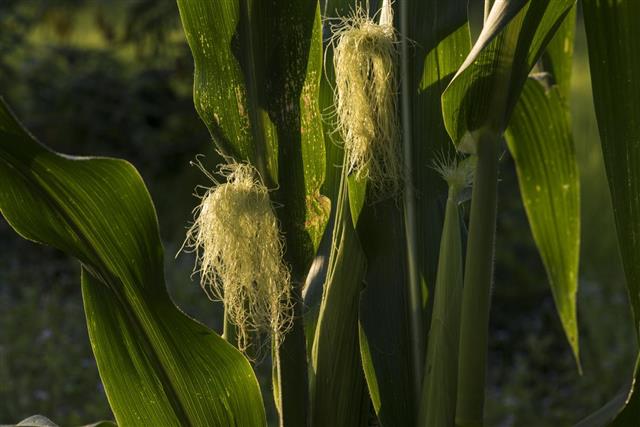
In order to propagate a corn plant from stem cuttings, you require a matured cane, sharp knife, and potting supplies. Detailed instructions for collecting the cane cuttings, rooting them, and transplanting the new corn plants are highlighted in this article.
The corn plant is a preferred choice of houseplant for many hobbyists. Known by different names like Cornstalk Dracaena, Striped Dracaena, and Compact Dracaena, it is scientifically called Dracaena fragrans. Some people confuse it with the cultivated corn, its scientific name being Zea mays. You can identify this foliage plant from the sword-like, green or variegated leaves, and bare stem. What makes a corn plant so popular amongst gardeners is its easy maintenance, both indoors and outdoors. Also, you can obtain several copies of it, once the mother plant has matured.
Vegetative Propagation of a Corn Plant
Corn shares the same genus (Dracaena) with lucky bamboo. And similar to lucky bamboo, multiple corn plants can be produced from a single shoot with the help of stem cuttings. When kept in moist soil and favorable conditions, these vegetative cuttings root easily. As for propagating a corn plant vegetatively from leaves and roots, the above technique is not applicable. In fact, a few plants can be propagated from leaves and roots. For new growths to take place, the vegetative parts should have sufficient meristematic cells, which are not there in the leaves and roots of a corn plant.
Propagating a Corn Houseplant by Cane Cuttings
One word of caution is, this houseplant is poisonous and you should handle it safely. It is best to split the mother plant or stock plant in spring and summer. If you already own a matured corn plant, you can begin with the propagation process. Or else, purchase a healthy starter plant from your local nursery. If you prefer the one with variegated leaves, select the D. fragrans ‘Massangeana’ cultivar. Its leaves have yellow stripes in the center, all along their length. Take proper care of the plant and wait till it becomes fully mature for obtaining its stem cuttings. Follow the step-by-step guidelines mentioned below, and you can surely propagate corn plants on your own.
Step #1: Keep the Supplies Ready
First of all, gather the materials required for your project. You will need a sharp knife, potting mixture (sand or peat moss), starter pots (2½ inch in diameter), and rooting hormone (for inducing quick development of roots). Fill the starter pots with the potting medium or peat moss till three-fourth of the pot height, and water them. Excess water will be drained off by the time you are ready to use them.
Step #2: Select a Healthy Stem
Hoping that your Cornstalk Dracaena is matured and has multiple stalks, you can choose a healthy, bare cane for propagation. Ensure that the cane you have finalized for cutting is free of diseases and scars. A simple way is to examine the small buds that are present in between leaf scars. If these dormant buds are intact, new shoots will develop, and vice versa.
Step #3: Take the Cane Cuttings
While proceeding for this step, you need to take care of three things – the length of the cuttings, making smooth cuts, and ensuring minimal injury to the mother plant. Keeping these things in mind, cut the cane about 6 inches above the soil. Then, make smaller sections (about 3-4 inches in length) out of the trunk, ensuring that each part has a dormant bud in it. Place the cane cuttings properly to avoid unnecessary damage.
Step #4: Prepare the Cuttings for Rooting
In case, you are using a rooting hormone, follow the usage directions strictly. You may require to dip the lower section of the stem cuttings (about 1½ inch) into the rooting hormone before introducing them in the individual pots. Another approach is planting the cane cuttings directly without dipping in the hormone. For this, insert the cuttings into the potting medium with the buds facing upward.
Step #5: Care for the Cane Cuttings
Besides upright planting of the cuttings in the potting mix, you can place them horizontally too. The only requirement is upward pointing of the buds. Whichever method you have adopted, place the pots in areas where they receive indirect sunlight for 4 hours or more every day. Keep the soil moist to induce formation of roots and shoots. Also, you can cover the cuttings with plastic bags to maintain warm temperature.
Step #6: Transplant the New Plants
After about 4 weeks, you will notice new shoots developing from the dormant bud, i.e., area in between the leaf scars. By this time, new roots are also formed at the base of the cuttings. This is the perfect time for transplantation. For the purpose, choose pots of appropriate size, and fill them with well-drained, commercial potting mixture. Introduce the new plants carefully, so that the young shoots and roots are not damaged.
Caring for a corn plant is very easy, and it grows well even with least maintenance. If the plant is native to your region and you maintain it outdoors, it will most likely produce fragrant flowers after some years. But, those maintained indoors rarely flower. To control the height of indoor corn plants, you can trim them at any time of the year.






